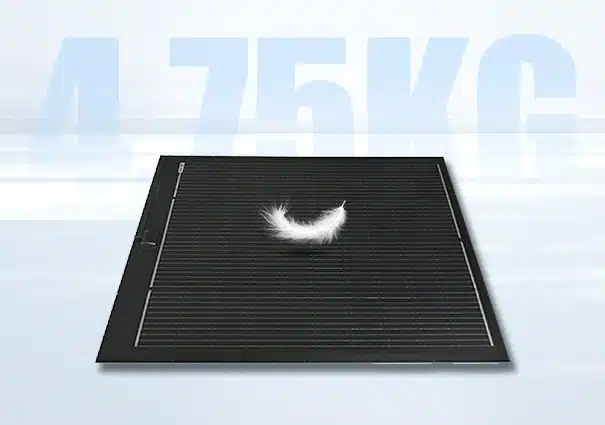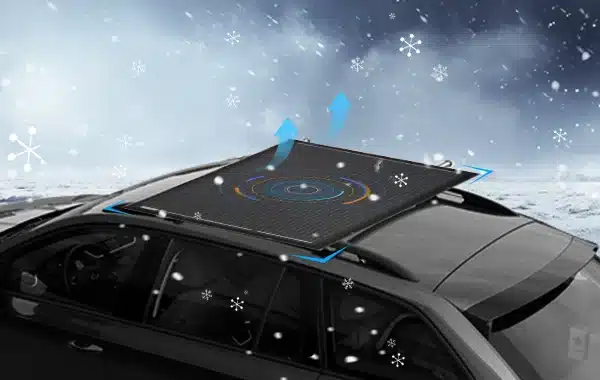As the demand for sustainable energy solutions grows globally, solar technology has rapidly advanced. Among various solar products, lightweight PV panels have gained attention for their unique lightweight feature. However, many might not be fully aware of the differences between lightweight PV panels and traditional solar panels. This article will detail the primary differences and respective advantages of these two types of solar panels.
What are lightweight PV panels?
Lightweight PV panels utilize advanced materials and manufacturing techniques, possessing several distinct characteristics:
- Lightweight: These panels are usually made from light materials like thin-film solar cells, weighing about half as much as traditional silicon-based solar panels, making them perfect for weight-sensitive applications.
- Flexibility: Some lightweight PV panels can bend and are thus installable on curved surfaces such as vehicle roofs or boats.
- Easy Installation: Due to their lighter weight, these panels are generally simpler and quicker to install, reducing installation costs and time.

Comparison with traditional solar panels
- Efficiency Comparison
Traditional Solar Panels: Primarily use crystalline silicon with conversion efficiencies typically between 15% and 22%.
Lightweight PV Panels: Although early lightweight panels had lower efficiencies, the efficiencies of newer generations of lightweight PV panels have now nearly matched or equaled those of traditional panels. Sungold’s solar panels are now around 21% to 25% efficient.
- Installation Comparison
Traditional Solar Panels: Require sturdy mounts and sufficient space, making the installation process relatively complex.
Lightweight PV Panels: These can be rapidly deployed on various surfaces, especially suitable for irregular or mobile surfaces.
- Durability Comparison
Traditional Solar Panels: Designed for long-term fixed installations, they are highly durable and can withstand harsh weather conditions.
Lightweight PV Panels: While adaptable, they might be less durable under extreme conditions.
- Cost Comparison
Traditional Solar Panels: Higher initial investment cost but lower long-term operational costs.
Lightweight PV Panels: They may be pricier per unit, but the ease of installation can lower overall costs, particularly in scenarios requiring quick deployment or temporary installations.
Application of lightweight PV panels
Residential and Commercial Buildings
Lightweight solar panels are ideal for buildings with roofs that cannot support the weight of traditional solar panels. Their reduced weight minimizes structural stress, making it possible to install solar technology on older buildings, temporary structures, or in areas with specific building regulations regarding load-bearing capacities.
Transportation
- Vehicles: Lightweight panels can be integrated into the roofs of cars, buses, and other vehicles to provide auxiliary power for charging batteries or powering onboard electronics. For electric vehicles, they can extend the range by continually charging the battery.
- Marine Applications: Boats and yachts also benefit from lightweight solar panels. They can be molded to fit the contours of a vessel’s deck or roof, providing a continuous power supply without adding significant weight or wind resistance.
Portable and Emergency Power Solutions
Portable solar kits often utilize lightweight panels for mobile power solutions. These are crucial for camping, remote fieldwork, or emergency situations where power needs to be restored quickly and without heavy equipment. Their portability also makes them perfect for military use, where rapid deployment and mobility are essential.
Aerospace and Drones
In aerospace, minimizing weight is critical. Lightweight solar panels are used in satellites and high-altitude balloons to provide power without compromising the flight characteristics. For drones, especially those used in long-duration flights for surveillance or research, lightweight panels can significantly extend operational capabilities.
Agriculture
Farmers are using lightweight solar panels to power sensors and irrigation systems in remote fields where traditional power sources are not viable. These panels can be easily transported and installed in vast agricultural lands, helping to automate and improve farming practices with a sustainable energy source.
Wearable Technology
Solar-powered wearable devices, such as backpacks with integrated solar panels or solar-powered watches, use lightweight panels for energy without adding bulk or discomfort, making solar power practical and accessible on the go.
Architectural Integration
Architects and designers are increasingly integrating lightweight solar panels into the aesthetic of buildings. These panels can be used on facades, glass, and other elements of a building’s exterior, not only to generate power but also to enhance the building’s appearance with eco-friendly features.
The pros and cons of lightweight solar panels
Lightweight solar panels offer a compelling alternative to traditional panels, particularly in applications where weight and flexibility are crucial. Here’s a detailed look at their advantages and disadvantages:
Pros of Lightweight Solar Panels
- Reduced Weight: One of the primary benefits is their low weight, which makes them suitable for surfaces that cannot bear heavy loads. This feature is particularly beneficial for older buildings, vehicles, and temporary structures.
- Flexibility: Many lightweight solar panels can be bent and adapted to fit curved surfaces like the roofs of RVs, boats, or even irregular building designs, allowing for more versatile installations.
- Easy Installation: Due to their lighter weight, these panels require less structural support, which simplifies the installation process. This can lead to lower labor costs and less intrusive installation work.
- Portable and Convenient: Their portability makes them ideal for mobile applications, including portable power packs for camping, mobile operations, and emergency power solutions.
- Less Invasive: For historical or architecturally sensitive buildings, lightweight panels offer a solar solution that doesn’t jeopardize the integrity of the structure.
- Improved Aesthetics: Flexible and lightweight panels can blend more seamlessly into building designs and vehicles, maintaining aesthetic values while providing energy.
Cons of Lightweight Solar Panels
- Lower Efficiency: Traditionally, lightweight solar panels, particularly those using thin-film technology, have had lower efficiency rates compared to standard crystalline silicon panels. This means they generate less power per square foot and might require more surface area to produce the same amount of energy as traditional panels.
- Durability Concerns: While advancements have been made, lightweight panels can be less durable than traditional panels. They may be more susceptible to damage from environmental factors like harsh weather conditions.
- Cost: The cost per watt of energy produced can be higher with lightweight solar panels due to their lower efficiency and the premium materials often used in their construction.
- Longevity and Warranty: Lightweight panels may not have the same long-term reliability as traditional panels, and they often come with shorter warranty periods, reflecting potential concerns about lifespan and performance degradation.
- Technology and Material Limitations: The materials and technology used for lightweight solar panels can limit their applications. For instance, certain lightweight materials might not perform as well under high temperatures or in cloudy conditions.
- Recycling and Environmental Impact: Recycling options for lightweight panels, especially those made with rare or composite materials, can be more limited compared to traditional glass and metal-based panels, potentially impacting the environmental benefits.
- Lightweight solar panels provide innovative solutions for applications where traditional panels are impractical. However, their adoption should be considered in light of specific needs, focusing on where their advantages outweigh the limitations. As technology progresses, the efficiency and durability of lightweight panels are likely to improve, making them more competitive with traditional solar technology.
Best lightweight solar panel: Sungold PA621
When it comes to the best lightweight solar panels, the Sungold PA621 series is undoubtedly the best on the market. Not only are these lightweight solar panels lightweight and easy to install, but they also offer excellent energy efficiency and long-lasting durability, making them a major revolution in traditional solar panels. Here are some of the outstanding features of the Sungold PA621 that make it a leader among lightweight solar panels:
High Efficiency
The Sungold PA621 series utilizes highly efficient monocrystalline silicon solar cells with a conversion efficiency of up to 22.7%. This high efficiency ensures maximum energy output even in low light conditions, comparable to traditional solar panels.
Ultra-lightweight design
Another significant advantage of the PA621 series is its ultra-lightweight design. It is 50% lighter than conventional glass solar panels, weighing only 2.82 kg, which greatly reduces the burden of installation and transportation. This feature makes the PA621 ideal for environments where relocation is required or installation space is limited, such as on top of a caravan or a city balcony.
Hot Spot Protection Technology
The unique “Zero Hot Spot” technology is one of the major technical highlights of the PA621 series. This technology effectively prevents the hot spot effect caused by partial shielding, reduces power loss, and ensures stable power output in environments with frequent vibrations, such as a moving caravan.
Outstanding Thermal Insulation
PA621 is not only lightweight but also has excellent thermal insulation properties. Its back sheet material has a thermal conductivity of only 0.2W/(m-k), which effectively slows down power degradation in high-temperature environments and ensures that the solar panels can maintain their high efficiency even in extreme climatic conditions.
Environmentally Friendly
Choosing ultra-lightweight solar panels without glass helps to reduce the carbon footprint during production and transportation. the PA621 series is committed to improving the environmental friendliness of our products while providing energy solutions, helping to promote sustainable development.
Long-Term Guarantee
The Sungold PA621 series comes with a warranty of up to 10 years, which not only shows Sungold’s confidence in its products but also provides consumers with a long-term guarantee for their use.
Sungold PA621 series, with its innovative technology and user-friendly design, is the best choice among lightweight solar panels, especially for those who are looking for an efficient, environmentally friendly, and easy-to-install solar solution. Whether it is used for RV travel or energy self-sufficiency for city living, PA621 delivers performance beyond expectations.
Whether to choose lightweight PV panels or traditional solar panels largely depends on specific application needs and installation environments. Lightweight PV panels excel in mobile environments and temporary installations, while traditional solar panels are more suitable for fixed installations requiring long-term, stable energy output. As technology continues to evolve, the performance and cost-effectiveness of lightweight PV panels are expected to improve further, broadening the application prospects in the solar energy field.













